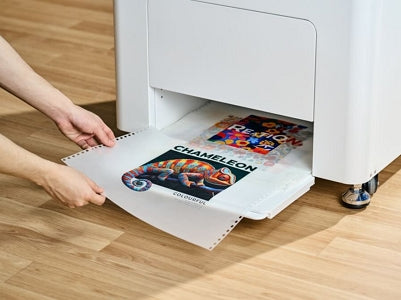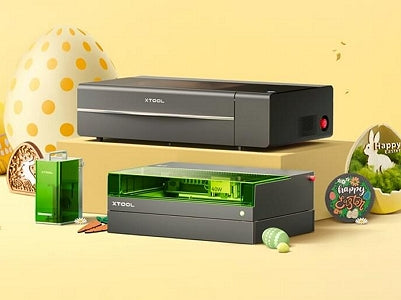How to Make Custom T-Shirts at Home?
T-shirts are a staple in everyone's wardrobe, easily bought from various marketplaces. However, creating a custom T-shirt at home brings a unique joy. The process lets you use shirts as a canvas for expressing creativity, which adds a special connection to what you wear.
Beyond personal satisfaction, custom T-shirt creation opens the door to business opportunities. With the right approach and tools, you can turn this hobby into a profitable T-shirt business.
This article explores the best methods for making custom T-shirts at home. It compares these techniques and outlines important considerations for choosing the right method. Whether you’re looking to express yourself or embark on a new business venture, the article will guide you through the process of creating custom T-shirts, step by step.
In This Article
- How to Make Your Own T-Shirts: Methods for T-Shirts Printing
- How to Make Your Own T-Shirts: Which Printing Method to Choose?
- How to Make Custom T-Shirts With xTool Screen Printer
- Starting a business: How to Make Shirts to Sell?
- FAQs on Making T-shirts
- Conclusion
How to Make Your Own T-Shirts: Methods for T-Shirts Printing?
Printing on fabric may not be as simple as on paper, yet you have multiple options at your disposal. Specifically, for T-shirts, there are more than 9 printing methods available. Among these, five methods stand out for their popularity and ease of implementation at home.
Let’s examine these five methods individually:
Heat Transfer Vinyl Printing
Tools: Vinyl cutter, weeding tool, iron/heat press
Materials: Heat Transfer Vinyl
Level of difficulty: Easy

Heat Transfer Vinyl (HTV) printing is the simplest of all t-shirt printing techniques. In HTV, designs are cut out of a colored vinyl sheet and heat-pressed onto the fabric.
HTV is straightforward for beginners. It’s recommended if you want to make custom one or two shirts for yourself. However, making multiple ones can be challenging and time-consuming.
Process: Create a digital design and then use a specialized vinyl cutter, like xTool M1, to cut out that design off a colored HTV sheet. Next, weed away the excess vinyl around your design with weeding tools. Position your design on the T-shirt and apply heat using a heat press or an iron. The heat adheres the vinyl to the fabric, leaving your design on the shirt.
Pros:
- Great for dark fabrics.
- Multiple color options.
- Design customization is easy.
- Vinyl stickers can be applied even on small corner areas.
Cons:
- Takes more time to bulk-produce items.
- Prints can crack over time.
Screen Printing
Tools: Silkscreen, frame, squeegee, photo emulsion, UV light source, transparency sheet
Materials: screen printing ink, t-shirt
Level of difficulty: Moderate

The traditional screen printing process is fun for many, but the journey is quite long. In this case, a stencil (silkscreen) is made and then ink is applied through that layer to transfer the design.
Screen printing is one of the antique printing methods that’s still popular today due to the vibrancy and durability of its prints. Printing a stencil takes time but once made, the same can be used for making multiple copies of the same design. It’s recommended for those getting into the t-shirt business.
Process: Prepare your screen with a photo emulsion, then expose it to a UV light source with your design on a transparency placed on top. This process hardens the emulsion not covered by your design. Wash the screen to reveal the stencil, then place it on your T-shirt. Pour ink onto the screen and use a squeegee to press the ink through the screen and onto the shirt. Cure the ink to set it.
Pros:
- Vibrant, vivid, and textured designs are achievable.
- Designs last quite longer and withstand multiple washes.
- Works on all types of fabrics.
- Bulk production is relatively easy and cost-effective.
Cons:
- The traditional route is time-consuming.
- Not ideal for photographic or intricate patterns.
DTG (Direct to Garment, Digital Printing)
Tools: DTG printer
Materials: T-shirt, inks
Level of difficulty: Easy to Moderate

DTG is very similar to how a typical printer prints on a sheet paper. However, it uses a specialized printer to sprinkle ink onto fabric, transferring process. Digital printing is also simple, provided you’re aware of operating a simple DTG printer. The method makes high-quality detailed prints and is ideal for both small batches and one-offs.
Process: Feed a digital design to a printer and insert fabric in its tray. As you initiate the process, it quickly sprays ink directly onto fabric based on the design.
Pros:
- Great for photographic and personalized design patterns.
- Quicker than most printing methods.
- Ideal for urgent tasks.
- Works best on lightweight fabrics like cotton.
Cons:
- Prints can start fading after a few washes.
- High upfront cost.
Sublimation Printing
Tools: Sublimation printer, heat press
Materials: Sublimation paper, ink and polyester t-shirt
Level of difficulty: Moderate

In sublimation printing, design is transferred via the process of sublimation. The process is known for its ability to produce full-color, detailed designs that are well-integrated into the fabric. However, it requires specific materials and tools, making the setup more complex.
Process: Print the design on paper with sublimation ink. Place this paper on the t-shirt and heat-press. Due to heat, the ink vaporizes and diffuses into the fabric and bonds with it. The key is to use a T-shirt that is either 100% polyester or has a high polyester count for the best results.
Pros:
- Best for full-color or photographic prints.
- Prints get embedded within the fabric, maintaining a smooth and soft finish.
- Prints are resistant to cracking.
Cons:
- Only works best on light fabrics.
- Doesn’t work well on natural fibers.
Embroidery
Tools: Embroidery machine (for machine embroidery) or needle (for hand embroidery), embroidery loop.
Materials: Threads, stabilizer, or fabric to embroider one.
Level of difficulty: Depends on design and tools.

Embroidery on T-shirts adds texture and depth, making the design stand out. For machine embroidery, first create or obtain a digital embroidery design file compatible with your embroidery machine. Place a stabilizer behind the area to be embroidered to support the fabric, then position the fabric in an embroidery hoop. The embroidery machine uses the design file to stitch the design onto the fabric.
Hand embroidery, although more time-consuming, follows a similar process without the machine, requiring you to manually stitch the design using an embroidery needle and floss.
Pros:
- Extremely durable designs; last a lifetime.
- Unique 3-dimensional appearance.
- Works on all materials.
- Extensive customization options.
Cons:
- A time-consuming process, especially if using hand tools.
- Highly detailed or textual designs may not translate well with embroidery.
How to Make Your Own T-Shirts: Which Printing Method to Choose?
Now that we have explored the five popular techniques, one may ask which one is the best and what method should I use?
The answer is not that simple as the best method depends on various factors. You’ve to consider these factors and then make a choice.
Design Requirements
Each method has its design specialty. For instance, screen printing is ideal for vibrant, textured designs. Sublimation and digital printing are great for complex and realistic photo designs. Similarly, if you want a 3D textured pattern that raises above the fabric, embroidery can be an option.
Printing Fabric
We have seen that some methods give the best results when used on certain fabrics. For instance, sublimation printing is recommended for polyester or synthetic material shirts. Digital printing gives great results on cotton and light-colored fabrics. Screen printing is one of the methods that works well on all fabrics.
Printing Area
The size of your design significantly influences the choice of printing method. Sublimation and direct-to-garment (DTG) printing are excellent for large, full-shirt designs due to their capability to print detailed and extensive designs with ease. For smaller, more focused designs, Heat Transfer Vinyl (HTV) offers precision and is a viable choice, especially for adding simple graphics or text.
Time and Volume
Efficiency is crucial, especially in a business context where time translates directly to cost. Screen printing is time-intensive to set up but becomes highly efficient for large orders, making it ideal for bulk printing.
HTV and embroidery, although less time-consuming for setup, can become laborious for larger quantities. Sublimation and DTG balance setup and printing time well, suitable for medium-sized orders that demand detail and color fidelity.
Upfront and Running Costs
Cost is a concern for both hobbyists and small businesses. The cost means both the initial investment and the running costs. If we start with screen printing, it does require a significant investment, but in the longer run the process becomes cost-effective. HTV offers lower startup costs but involves manual labor, impacting scalability.
Sublimation and DTG printers represent a higher upfront cost but offer detailed and vibrant prints at a lower per-unit cost for ongoing operations. Embroidery, with its high initial equipment cost, is best for projects where its unique texture and durability add value.
How to Make Custom T-Shirts With xTool Screen Printer
Screen printing comes out to be a favorable method that’s compatible with all fabrics. However, the traditional approach is time-consuming – it may take days to make a screen printing stencil.
xTool Screen Printer changes the game by reducing the stencil-making process to hours. Instead of emulsifying the silkscreen, photo exposing, drying, and washing, you just need to laser engrave a pre-coated silkscreen. And the screen printing stencil is ready.
Here’s a simplified method of how you can make custom t-shirts with xTool Screen Printer.

Step 1: Create a Design for the Stencil
Make a design where each color is on a separate layer, without any mixed colors or unnecessary lines. You can use graphic design software and then move your design to the laser engraver software, or just design directly in the laser software if it's simple.
Step 2: Prepare the Pre-coated Silkscreen
You'll get pre-coated silkscreens with the xTool screen printer. Put one in the frame provided, then load it into the laser engraver. Make sure the silkscreen is stretched and uniform.
Step 3: Laser Engrave the Design
Hit start to begin engraving. It only takes a few minutes to get your stencil ready. If your design has more than one color, you'll need to engrave a separate stencil for each one.
Step 4: Use the Stencil for Customizing
Stretch the T-shirt onto the xTool screen printer, then put your engraved stencil on it. Use the screen printing ink included in your kit to spread over the stencil with a squeegee. Do this for each color stencil you have. Let the ink dry and the shirt is ready for use.
Starting a business: How to Make Shirts to Sell?
Interested in starting a T-shirt printing business after discovering how straightforward the process can be? Hold on and don't dive in headfirst. Instead, take the time to thoroughly research and prepare.
The following steps can help you organize and set the foundation for your venture:
1. Identify Your Niche
The first thing is research. You to need find a specific market or audience that resonates with your brand. Consider interests, demographics, or trends that you are passionate about.
2. Select Your Materials
Choose high-quality T-shirts that are easy to source and available at cost-effective prices. Do consider premium ones if your budget allows. Consider comfort, durability, and sustainability.
3. Choose Printing Methods
Based on your design complexity, volume, and material, select a suitable printing method. Evaluate the pros and cons of heat transfer vinyl, screen printing, DTG, and sublimation printing in terms of cost, quality, and scalability. Choose the one that becomes cost-effective in the longer run.
4. Create Unique Designs
Designs should be your USP – must speak of your brand identity. Design shirts that stand out and appeal to your target niche. Use original artwork or hire designers to bring your vision to life.
5. Set Up Your Business Legally
Register your business, get a tax ID, and take care of any legal requirements to operate your T-shirt business legally in your jurisdiction.
6. Build an Online Store
With a great digital audience, soft launch your business online. Create an eCommerce website to showcase and sell your shirts. You can create your own site through Shopify, or create a store at marketplaces like Etsy.
7. Market Your Brand
Use all social media platforms to reach your target audience. Engage with your community, collaborate with influencers, and utilize ads to increase your brand's visibility.
FAQs on Making T-shirts
What Do You Need to Make Your Own T-shirts?
To make your own t-shirts you just need the xTool screen printing package. It contains pre-made stencils, inks, and everything that’s required for customizing a t-shirt.
What’s the Best Way to Make Custom T-shirts?
The best and quickest way to make custom shirts is through Heat Transfer Vinyl. Get a colored vinyl sheet, cut it with a vinyl cutter (xTool M1), and heat press it onto the shirt. A customized shirt is ready in minutes.
Conclusion
Given the multiple options, choosing a method for your t-shirt printing venture can be a challenging choice. However, if you’re aware of the strengths of each process, choosing one that meets your design requirements becomes easy. We’ve narrowed down those critical consideration factors to help you make the right choice.
If you’re considering the screen printing method for the T-shirt business, the xTool Screen Printer deserves attention. This comprehensive kit includes everything you need to start: pre-coated screens, inks, a squeegee, and screen printing frames.




